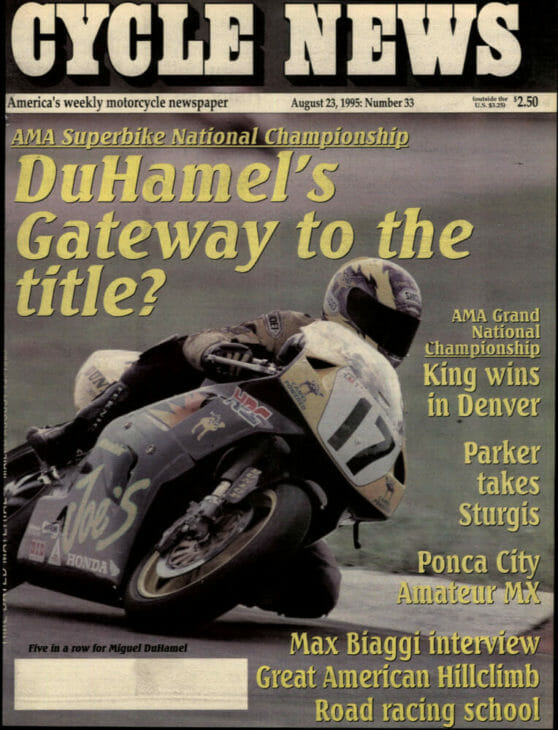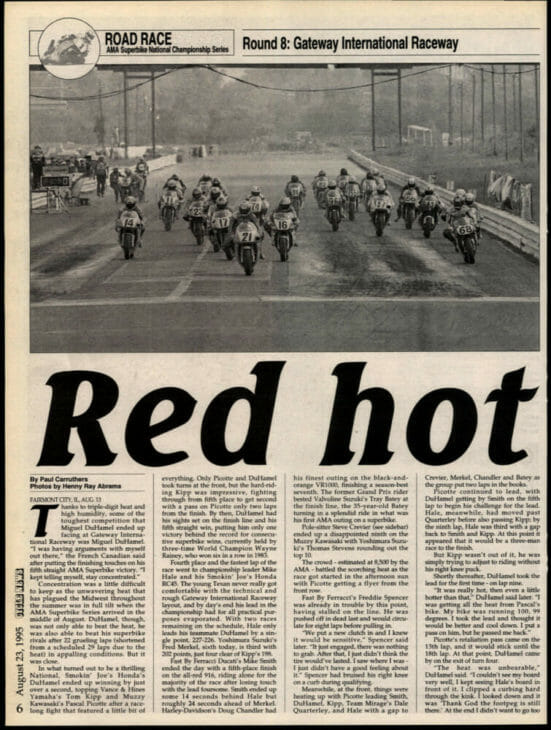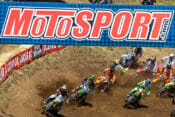Archives: St. Louis Scorcher
Ask anyone about the 1995 AMA Superbike event at Gateway International Raceway and the first thing they’ll say is, “It was hot!” The ’95 race, held at Gateway, which was just across the Mississippi River from St. Louis, proved to be the one and only AMA National Road Race ever hosted by the track. In spite of tremendous pre-race area publicity, radio and TV ads and promotion by St. Louis area dealerships, when race weekend came, very few fans showed up. The problem was an oppressive heatwave that hit the area. The race weekend was held in near triple-digit heat and high humidity. Not only did it make it difficult at best, for fans to try to enjoy the racing, but riders and tires had a tough time dealing with the heat as well.
Archives: St. Louis Scorcher

Gateway International Raceway, opened its newly-built road course in 1985. Prior to that the facility was a drag strip and the strip was used as the main straight for the road course. Braking for turn one was done on the launching area for the drag strip, so the traction in that area of the track was always different from every other part of the track.
Club races had been held at the track since it’s opening. It had even hosted a number of WERA and AMA National Endurance events, so the circuit wasn’t totally unknown to many of the racers who showed up to the first AMA Road Race National in 1995.
The very fact that a national was being held at Gateway was somewhat of an anomaly.
Even by the less stringent safety standards of the mid-1990s, the track was quite dangerous with Armco barrier lining some very close run-off areas. The biggest concern was the final corner leading onto the dragstrip. It was a fast, sweeping left hander and riders heading onto the straightway, were always trying their best to get a good drive out of the turn. Problem was, the guardrail was right there lining the outside of the track. Any mistake in that area of the circuit could prove catastrophic. A club racer died hitting the haybale-covered barrier just a couple of years earlier.
Gateway was a last-minute addition to the 1995 AMA Superbike calendar. AMA Pro Racing was scrambling to fill its racing calendar after a new rival North American Superbike Series (NASB) released its 1995 schedule, which included several of the prime AMA Superbike venues.
Early on it appeared the upstart NASB, headed by former AMA Road Racing Manager Roger Edmondson, would not only get many of the best tracks, but some of the factory teams seeing that the AMA Superbike Series schedule was suddenly almost non-existent.
AMA Pro rallied and hastily threw together a schedule that ultimately included some tracks that regularly hosted club events, but were questionable, in terms of safety and facilities on the pro level.
Eventually all the major teams publicly stated they would be racing in the AMA series. The AMA scheduled one event on the same weekend as NASB, putting Indianapolis Raceway Park up against NASB’s race at Mid-Ohio. Most of the tracks began to realize that the promises NASB made to them, specifically participation by the top teams and riders, was not forthcoming so they came back to the AMA.
A few of the hastily planned AMA events were taken off the calendar, but two of the tracks stayed on as a result of the AMA vs. NASB fallout. One was Gateway and the other was Firebird International Raceway in Chandler, Arizona. Both tracks were marginally capable, at best, of hosting professional events. AMA Pro Racing went to the major expense of removing and then re-installing 230 feet of Armco, but still there were plenty of places where just a thin layer of haybales were all that protected the riders from unforgiving steel.
Understanding that the first-time race needed a boost to get off the ground, AMA Pro Racing poured a lot of money into promoting the event. Radio and TV ads inundated the St. Louis market, a high-powered promotional company from Los Angeles was brought in to do promotions. Local dealers wholeheartedly supported the race and featured posters and sold tickets. AMA Superbike points leader Miguel Duhamel was brought in early to do radio and TV appearances and he worked the better part of two days and traveled as far away as Carbondale, Illinois (100 miles away). Every detail was covered to ensure everyone within a couple of hours of the track knew about the race.

Then came race weekend and one of the worst heat waves to hit St. Louis in years. It was officially 98 degrees in St. Louis all three days of the event with close to 80 percent humidity. Trackside thermometers used by the teams showed temperatures as high as 103. It was so hot that the National Weather Service put out heat advisories urging people to stay inside in air-conditioning, calling the temperatures dangerous to the elderly and children.
The result was a small, but certainly hardy crowd who braved the elements. Estimates were that perhaps as few as 1500 fans came out to watch the races in spite of the promotions. It was a financial disaster for AMA Pro Racing, one that took several years for it to recover from.
Bob Dragich, reporting for Roadracing World wrote:
The heat was unbearable, the humidity intolerable, the track questionable, but the racing unbelievable.
Surprisingly, it was Canadians from the cold north, who did well in the blistering St. Louis heat. Steve Crevier won the Superbike pole on a Muzzy Kawasaki. A couple of fellow Canadians in Pascal Picotte (Muzzy Kawasaki) and Miguel Duhamel (Smokin’ Joe’s Honda) joined him on the front row. In the race it was factory Honda’s Duhamel who preserved his tires, then moved up through the field to win the race over Yamaha’s Tom Kipp and Picotte, who finished third after leading much of the race. It was Duhamel’s fifth win in a row. He would go on to win that year’s AMA Superbike Championship.
Duhamel said the biggest problem was trying to stay focused in the face of the intense conditions.
“I kept telling myself to concentrate,” Duhamel said. “The heat just took everything out of you. I really had nothing left at the end.”
The heat blistered a lot of the riders’ tires. Freddie Spencer stalled his Ferracci Ducati on the start and then charged through the field, but his torrid pace cooked his tires and he had to retire early. Several others said they were merely holding on with no grip in the closing laps.
The vast amount of money spent promoting the race and the cost of making the track safer, combined with the heat that kept fans at home, was the death blow to Gateway. Even though several riders reported liking the track and seeing potential there, AMA Pro Racing wanted nothing to do with the facility after the financial disaster.
And the few, the brave, the hardcore fans who showed up to watch the race? They’ll tell you it was hot – just ask them.
—
You can read the digital edition of this story here: https://magazine.cyclenews.com/i/1146955-cycle-news-2019-issue-29-july-23/122
